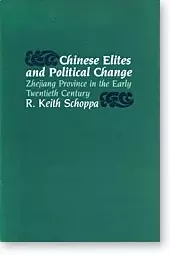
作者:R.KeithSchoppa
出版社:HarvardUniversityPress
副标题:ZheijangProvinceintheEarlyTwentiethCentury
出版年:1982-4-27
页数:280
定价:USD62.50
装帧:Hardcover
ISBN:9780674123250
内容简介
· · · · · ·
With the Qing Dynasty reform efforts (1901–1911), abolition of the civil service examination (1905), and the end of the monarchy (1912), the first three decades of the twentieth century brought important changes to the elite of Zhejiang Province. This book examines the social backgrounds, public activities, careers, and decision-making of local and provincial elites—that is, nonprofessional men who had taken on public duties when the multiplying problems of government had resulted in a general breakdown of public functions.
While elites in early twentieth-century China have often been caricatured as militarists, corrupt bureaucrats, evil landlords, and ineffectual reformers, they have not been clearly understood or closely analyzed. Since the seventeenth century, elites had been assuming increasing responsibility for funding and managing public projects, and by the twentieth century had expanded their activities still further. In the first three decades of the century, they experienced substantial personal and communitarian development; it was the structures and processes developed by these elites that subsequent regimes—Guomindang, Japanese, or Communist—had to build upon and adapt.
Keith Schoppa divides the counties of Zhejiang Province into four zones according to level of political and economic development and scrupulously analyzes the complex processes of remolding society at the local and provincial levels. By delving beneath the heroic figures and large movements of Chinese political life in this century, he reveals the common factors that make China a part of the worldwide story of reconstruction, reform, and developmental change.
作者简介
· · · · · ·
R. Keith Schoppa is Professor and The Edward and Catherine Doehler Chair in Asian History at Loyola University Maryland. He has a Ph.D. in modern Chinese history from the University of Michigan. He is author of a number of monographs and textbooks on Chinese history, including Blood Road, which won the international Association for Asian Studies 1997 Levenson Prize for the best book on twentieth century China.
目录
· · · · · ·
I. The Context of Elite Activity
1. Elites and Political Development: The Historical Context
2. The Four Zhejiangs
3. Common Organizations in the Four Zhejiangs
II. The Sociopolitical Ecology of the Four Zhejiangs
4. Inner-Core Elite Career Bases and Patterns
5. Inner-Core Elite Collectivities: Social Groupings and Voluntary Associations
6. Inner-Core Elites and Political Decision Making
7. Outer-Core Political and Elite Structures
8. Inner-Periphery Political and Elite Structures
9. Outer-Periphery Political and Elite Structures
III. Locality, Province, and Nation in Early-Twentieth-Century Politics
10. The 1911 Revolution
11. Patterns of Nonofficial Elite Provincial Politics: Assemblies, Factions, and Coalitions
12. The Emergence of Outer-Zone Elites in Provincial Politics: The Jin-Qu-Yan-Chu Association, Political Ideals, and the Guomindang Victory
Conclusion
Appendix A. The Units of Analysis
Appendix B. Data for County Classification
Appendix C. Methodological and Source-Related Problems
Abbreviations Used in the Notes
Notes
Bibliography
Glossary
Index
评论 ······
看作者简历这应该是博士论文出书,问题意识和方法上的启发大于各种结论。形成有意义的问题(清末民初政治转型与地方精英角色),寻找已有的相对成熟的框架(施坚雅的地方政治社会体系分层模式),聚焦一个相对可控的时空(经济发达、开放较早、又是革命起源地的浙江省,1910-20年代),寻找相应的原始材料(地方志,报纸,地方档案),一步步设计解决中小问题的方案(如以经济发展与经济系统地位划分中心与边远地区,以占有…
施坚雅模式在政治史的实际运用例子,考察浙江在20世纪初的政治现代化过程。将浙江划为4个地理上不规整的区域,采用经济指标来衡量政治背景,以专业和自治团体的产生来作为政治现代化的标杆,在当时都是比较创新的想法。缺点在于太抽象,模型-数字的结论不能返回到历史故事里去,导致对江南近代化不感兴趣的人会觉得“读完了就完了吧”。不过这只是从政治史回归的角度“强人所难”啦,一本好书。
不知道这算不算结构主义的历史学做法?
一部老书,用施坚雅模式类型化解释了“散装浙江人”,结构主义味道比较重。虽然说许多呈现的细节对于浙江人来说不足为奇,但有些细节是值得关注的:1.所谓“新政”和“革命”从核心走向边缘的问题,辛亥革命在边缘区是一种“自发”还是“被带动“的;2.政府与精英的关系。边缘区呈现出寡头政府指导士绅搞现代化的现象;3.国民党革命尤其是412政变后金衢严处人士在省级事务中的崛起;4.边界意识与“浙江意识”。
评论前必须登录!
注册